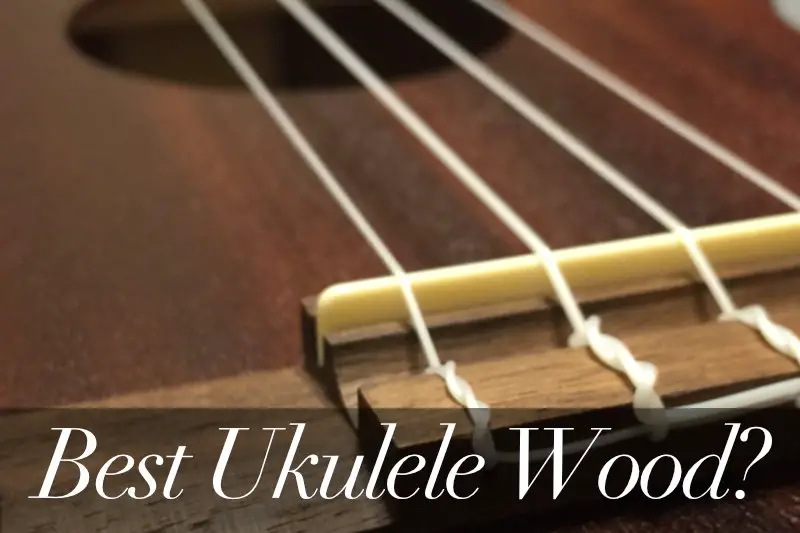When you first start playing, you might not think much about the best wood for an ukulele. At the very beginning of your journey with this instrument, you might not know much beyond Iz’s beautiful voice and songs by Train or Jason Mraz. In fact, much of the Indie-pop world has fallen in love with the ukulele. But there are some serious differences when it comes to playing and sound when you switch up the wood for ukuleles, and a little understanding will go a long way.
The best wood for ukuleles are tonewoods chosen for their great flexibility and sound. One of the best tonewoods is Hawaiian koa wood. You can make an instrument out of any wood, but what makes tonewoods special are the rich, wonderful sounds they produce when they’re made into an instrument.
Different ukulele tonewoods produce different sound qualities, and as string musicians, we need to pay attention. When you do research or go into a music store, you need to be a student of ukulele wood comparison. Otherwise, you may end up stuck with something that isn’t quite what you wanted.
Some of the articles on our site contain affiliate links. We're careful about what we review and recommend. As an Amazon Associate, we may earn something small from qualifying purchases. Thanks for the support!
Also, remember that for most musicians, the sound they look for from an instrument is a very personal thing. While one ukulele player might think that koa is an absolute must, another may truly love the mellow sounds of mahogany. Lean into those feelings and go with what you love. The more you love the sound of your ukulele, the more you’ll play it!
So, to get you up to speed, let’s look at some of the different kinds of ukulele tonewoods available and discuss the best wood for an ukulele.
Short history of the ukulele
Though stringed instruments didn’t begin in Hawaii, the ukulele is special because of the way early Hawaiians made the instrument their own.
Some say the word ukulele translates to “jumping flea”, which describes the fingerpicking style used by Portuguese immigrants who first made their way to Hawaii to work on the sugar plantations in the 1800s. However, Queen Lili’uokalani preferred “gift that came here”, so it’s up to interpretation.
Either way, when you look at the history of the ukulele in Hawaii, you can’t miss the connection to koa wood.
Ukulele and koa wood
Koa wood is a deeply-rooted part of Hawaiians’ history and heritage, and it was used to truly make the ukulele their own.
The word “koa” in Hawaiian means warrior, and acacia trees native to the islands earned this name in part through its extensive use in canoes and weapons for early people. It was briefly outlawed for anyone but royalty to own koa. But, eventually, koa came to be used by everyone. Everything from early surfboards to serving bowls, and yes, ukuleles were all made of koa.
Koa gets its beautiful color and iconic, curling grain from the volcanic soil the islands are made of, particularly on young islands like Hawaii, or the Big Island.
Koa forests were almost always under threat by ranchers who clear-cut them to make room for grazing cattle and pigs. Nowadays, ranchers understand the value of koa. You can read more about the history of koa and its science in this great article from Hawaii Bookmark.
Without koa, there may never have been the ukulele, undoubtedly one of Hawaii’s most popular cultural icons. So, now that we have an understanding of where the ukulele comes from and why koa wood is so important to its development, let’s dig into the types of wood we use today to make them.
Ukulele wood comparison
There are a number of different types of wood that manufacturers use to make instruments, but when it comes to ukulele wood comparison, most musicians end up preferring the tonewoods we’re about to list. Each wood has unique qualities that affect the sound you’ll get from the instrument. It’s what creates the specific tone, or timbre, that makes each instrument unique.
And, remember, even within the same type of wood you can find varying sounds depending on loads of different factors, including the finish applied, the specific grain pattern, and much more.
1. Koa wood for ukuleles
Arguably, the absolute best wood for ukuleles on our list is koa wood, which is made from a species of acacia tree that grows natively on the Hawaiian islands.
This makes sense, since as we just learned, ukuleles are native to Hawaii, too.
Koa wood is used for ukuleles, in part, because it’s the original, authentic ukulele wood. It provides a clear, bright sound and offers a superior, rich, and full tone. Not only that, but experts believe it also gives the best of both worlds when it comes to the beautiful tones of mahogany and rosewood ukuleles.
A koa wood ukulele might cost a little more than you expect to spend, but serious ukulele musicians will recognize koa wood as a worthy investment. Kala, one of the premier ukulele makers, uses koa extensively, which is a good indication of this wood’s importance in the ukulele community.
2. Teak for ukuleles
Let’s stay in the tropics for a moment and talk about the second hardwood on our list, teak.
Teak for ukuleles is a more affordable choice than other top-of-the-line hardwoods but holds its own as a durable and resonant choice.
It has a great sound and lends itself well to many styles of playing, including bluegrass. Teak ukuleles are great for beginners too because they’ll provide a great sound for the price.
Teak grows in tropical climates, and though it’s very affordable and great for beginners, it’s not the most popular hardwood on the lower-end market. Ukuleles made from teak can still be quite pricey.
3. Mahogany for ukulele
Mahogany is, for many, the most popular choice for ukuleles since it’s often the most widely available.
Musicians appreciate mahogany for ukuleles because it offers a rich, mellow tonality to their playing. Mahogany is a common hardwood, and it’s one of the most popular, cost-effective choices for stringed instruments. Lacking the brightness of koa, mahogany will offer a gentle, almost rustic tone.
More often than not, mahogany is the best wood for the ukulele neck as well as for the body.
Mahogany is an amazing wood. It’s beautiful in everything from furniture to musical instruments. We highly recommend mahogany ukuleles, especially as a first instrument.
4. Rosewood for ukuleles
The final hardwood on our list is rosewood. Although not as popular as some of the others, rosewood is still an iconic wood and deserves to be mentioned.
Rosewood is defined by an incredibly rich, mellow sound, and is mostly used to manufacture guitars. Ukuleles made from rosewood have deep tones and will fetch a high price in stores. Should you be lucky enough to own one, the body may be a blend of rosewood and some other softwood.
Because of the loud, resonant tonal properties of rosewood, some manufacturers temper it with softwoods like spruce and cedar in their instruments, which we’ll talk about next.
5. Cedar for ukuleles
The first of the softwoods on our list is cedar, a great choice often found in mixed-material ukuleles.
Manufacturers use cedar for ukuleles because of its wonderfully warm and dark qualities. Cedar for ukuleles is a perfect choice to tone down and balance the brightness of spruce or complement rosewood’s mood and resonance. This wood can stand alone, and when it does, it makes for a bass-rich ukulele.
Cedar is very common in ukuleles because many musicians feel it’s just right. Let us know in the comments if you’ve found cedar great in a blend or on its own.
6. Spruce for ukuleles
The other softwood we’ll mention is spruce, which is in a class all its own when it comes to bright, punchy notes.
We reach for a spruce ukulele when we want a sharp, bright tone to give our playing a crisp and playful quality. Spruce also tends to be naturally loud, so any ukulele that’s made from spruce will have a big sound. It’s a vibrant choice for bold musicians who want a lot of resonance in their playing.
Check out this great video that compares mahogany and koa to spruce. It really shows you the difference bright spruce wood makes on the ukulele’s sound.
Best wood for ukulele body
All of these tonewoods are amazing in their own rights, but we haven’t yet touched on a really important subject. Ukuleles are made of an instrument body and a neck. So, which wood is best for which part?
The best wood for the ukulele’s body is going to be one of the tonewoods we listed: koa, mahogany, rosewood, spruce, cedar, or teak.
You may also see ukuleles made from maple, another tonewood. Koa wood is prized as the holy grail for ukulele bodies, but mahogany is also a popular, best-selling choice.
As we mentioned at the beginning, every musician has their own preference when it comes to their instruments. As you develop your own sound and playing style, your choices will look different from others’ choices.
Benefits of Hawaiian Koa wood for ukuleles
Still, nearly every ukulele player will try out a Koa wood ukulele at some point in their career.
The benefits of Hawaiian Koa wood for ukuleles are many: quality, authenticity, sound, resonance, enjoyment, and the rich history of ukulele music. Koa wood ukuleles are a joy to play, and audiences love their bright, happy sound. The ukulele community holds up koa wood as the gold standard.
Koa can’t be beaten for a ukulele’s body, but what about the neck? Should you choose an all-koa ukulele, or are there other great wood choices for the neck?
Best wood for ukulele necks
Even the best tonewoods have their place. When it comes to the neck of your ukulele, you wouldn’t pick just anything.
The best wood for an ukulele neck will be hard and durable. Woods like mahogany or rosewood, for instance, are great for this purpose. Depending on your price range, you should go with a wood that can withstand a lot of use and play. Mahogany is a wonderful, cost-effective choice. But, if price is no issue, you’ll find no better choices than rosewood and koa.
The best wood for ukulele necks will not only be durable but feel great in a player’s hands. Time and experience teach us these things, but for a beginner, it’s tough to know how to make the right choice.
FAQ
So, by now, you probably have had some common questions pop into your head, and we’d love to try and answer them for you here.
1. What is a tonewood?
Not all wood is good for instruments. Tonewoods have resonant properties that make them well suited to making instruments. Tonewoods can amplify and color the sound produced by the vibrating strings of an instrument very well.
2. Can you DIY a plywood ukulele?
You absolutely can DIY your own plywood ukulele, and it might not sound half bad. Some websites even sell build kits. It won’t be a high-end instrument, but it will be loads of fun to build and play.
4. Why is koa wood special?
Koa wood is special because it makes a beautiful instrument with a superior tonality. It also has a rich history in Hawaiian culture.
Best wood for ukulele – final thoughts
The best wood for ukuleles can be boiled down to a few, high-quality tonewoods, the best being the Hawaiian koa wood. However, you should take some time and test different instruments in the store before you settle on an ukulele to bring home. Your instrument will serve you well for years to come, so take care when picking one out. And, take very good care of it when you get it home.
The ukulele is such a great, varied instrument. It’s loved by professional musicians as well as those looking for an easy musical instrument to start with.
What’s your ukulele made of? Which wood is on your wish list? Let us know your thoughts on the best wood for an ukulele in the comments, and check out our other articles on ukuleles!




